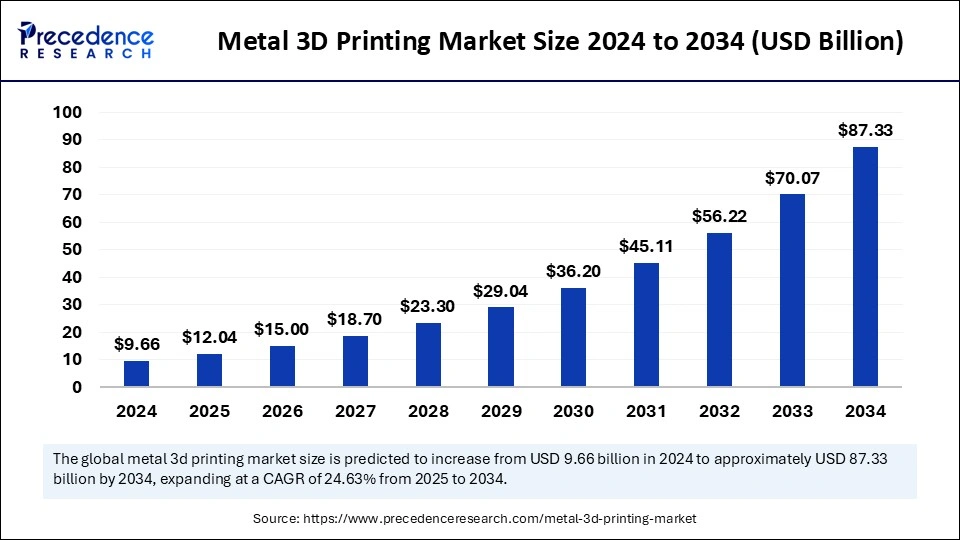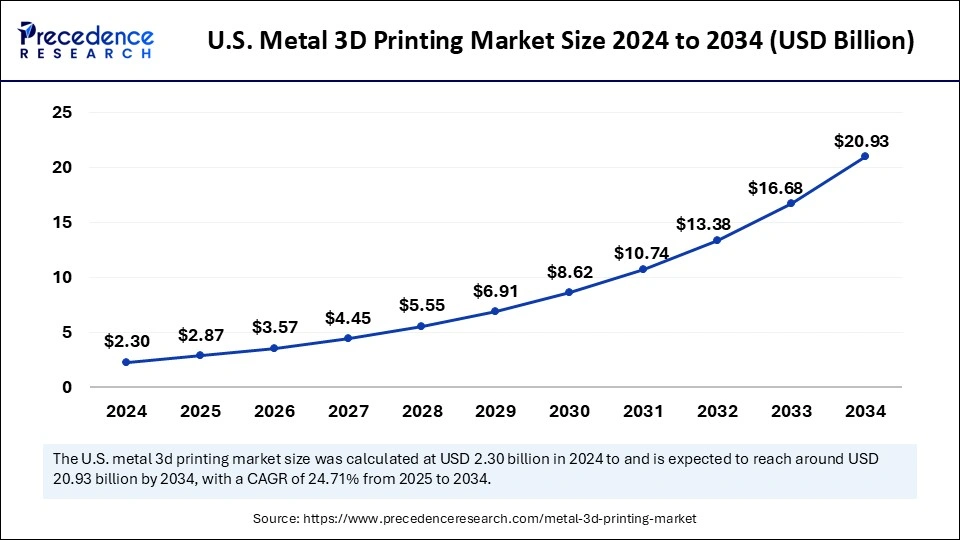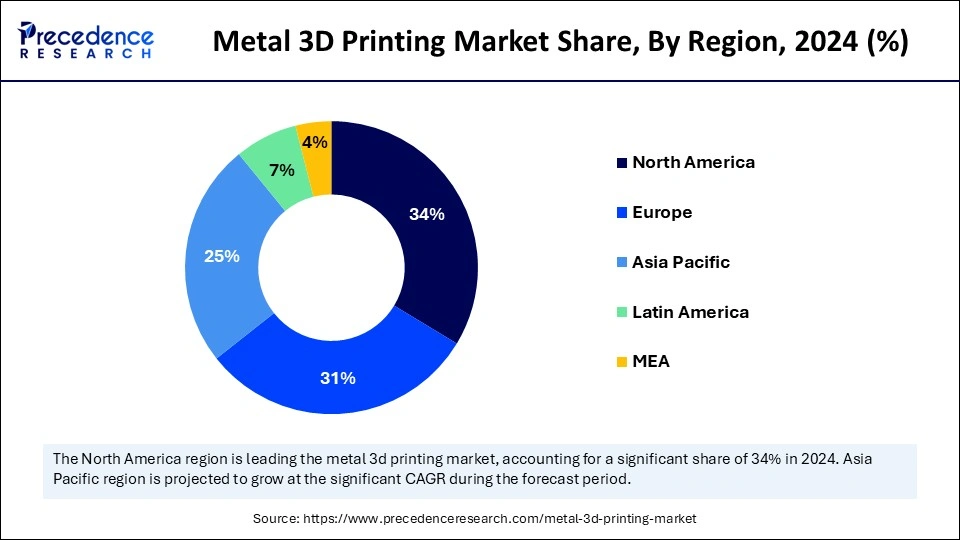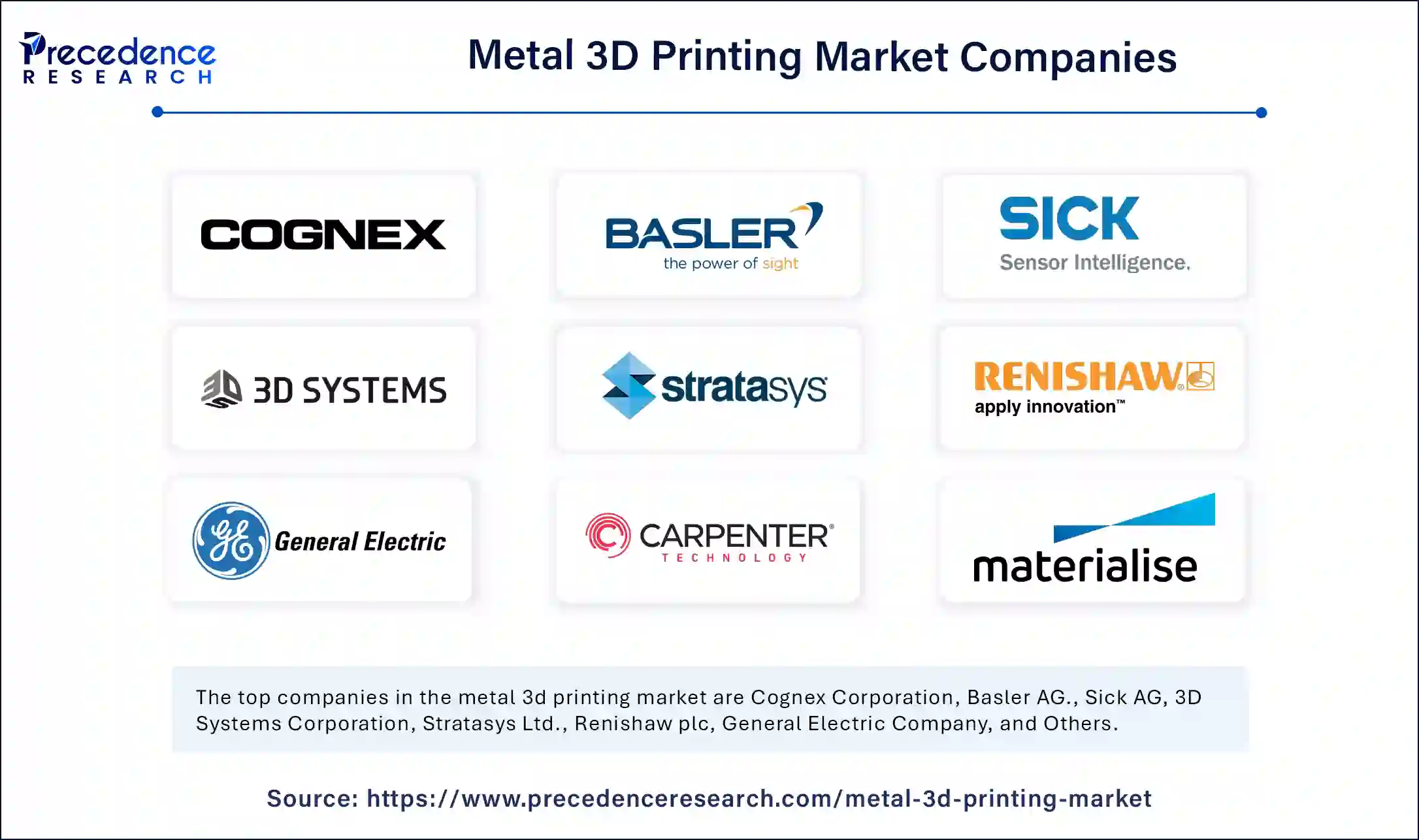November 2024
The global metal 3D printing market size is calculated at USD 12.04 billion in 2025 and is forecasted to reach around USD 87.33 billion by 2034, accelerating at a CAGR of 24.63% from 2025 to 2034. The North America market size surpassed USD 3.28 billion in 2024 and is expanding at a CAGR of 24.64% during the forecast period. The market sizing and forecasts are revenue-based (USD Million/Billion), with 2024 as the base year.
The global metal 3D printing market size accounted for USD 9.66 billion in 2024 and is predicted to increase from USD 12.04 billion in 2025 to approximately USD 87.33 billion by 2034, expanding at a CAGR of 24.63% from 2025 to 2034. The global metal 3D printing market is driven by rapid prototyping and the production of high-value components. The demand for metal 3D printing technology has increased for customized and complex productions, fueling the market growth. Increased adoption in aerospace and automotive verticals boosts the metal 3D printing market growth.

Artificial Intelligence in metal 3D printing technology is a transformative approach to enhance efficiency, accuracy, quality, design capabilities, and cost-effectiveness. AI enables light yet strong components by integrating with metal 3D printing technology. AI algorithms like generative design and topology optimization enable the creation of complex geometries and structures and maintain structural integrity to deliver lightweight and more efficient parts.
AI stimulation like finite element analysis (FEA) and computational fluid dynamics (CFD) improves structural optimization procedures such as temperature, speed, and layer thickness. The ability of Machine Learning to detect real-time defects and manual inspections improves quality control and prompt corrective activities. The rising leverage of metal 3D printing technology for sustainability concerns is driving attention toward AI-enabled optimization and predictive maintenance. AI enables efficient waste management processes and increases overall productivity. Cost-effectiveness and downtime reduction are the major trends leveraging metal 3D printing technology toward AI.
The U.S. metal 3D printing market size was exhibited at USD 2.30 billion in 2024 and is projected to be worth around USD 20.93 billion by 2034, growing at a CAGR of 24.71% from 2025 to 2034.

Industrial Adoption Boosting North American Market
North America dominates the global metal 3D printing market due to various factors including well-established industry and infrastructure and innovations and investments in research and development. North America is a hub for the aerospace and defense industry, driving significant adoption of metal 3D printing technology. The expanding automatic industry further increases the adoption of 3D printing for production parts. The existence of Advanced Research institutes and government funding for research and development in metal 3D printing technology boosts the market expansion. The increasing demand for Powder bed fusion (PBF) is the key trend in the market.
U.S. Metal 3D Printing Market Trends
The United States leading the metal 3D printing market in North America, driven by the rising adoption of technology in the aerospace, automotive, and healthcare industry. Will establish the healthcare industry of the United States playing a crucial role in adapting metal 3D printing technology. Technological advancements, such as 3D printing technologies and materials are a crucial factor contributing to growth. countries' rising focus on sustainability creating opportunity pathways for metal 3D printing technology.
Government Initiatives Fueling Asian Market Growth
Asia Pacific is seen to grow at the fastest rate in the upcoming years, driven by the high adoption of metal 3D printing technologies in various industries. Asian expanding industries like aerospace & defense, automotive, and healthcare are driving demand for metal 3D printing. Government encouragements like India’s ‘Make in India,’ China’s ‘Make in China 2025,’ Japan’s ‘Society 5.0,’ and South Korea’s ‘Smart Manufacturing’ initiatives are playing a favorable role in expanding the metal 3D printing technology industry in Asia. Asia is anticipated to witness a rise in demand for customized products to enhance the need for metal 3D printing.

Make in China’s Initiative Expanding Metal 3D Printing Manufacturing in China
China is leading the market with government initiatives such as ‘Made in China.’ Government investments in advanced manufacturing technologies are driving opportunities for metal 3D printing technology. Additionally, the well-established automotive industry and expanding healthcare leverage the need for edge technologies for cost-effective and high-quality benefits, including metal 3D printing.
Well-established industries and research institutions to expand the market in Europe
Europe is observed to grow at a considerable growth rate in the upcoming period. Europe has a well-established industry and infrastructure, such as aerospace & automotive and supply chains. The Aerospace & defense and automotive industries of Europe are a solid foundation for 3D printing technology adoption. Existing advanced supply chains and a strong network of manufacturers, suppliers, and service providers drive the adoption of edge technologies. The region is expected to witness significant growth in metal 3D printing adoption rate with strong government funding in research institutes.
U.K. Metal 3D Printing Market Trends
U.K. leading the metal 3D printing market in Europe. The U.K. is the leading provider of metal 3D printing equipment and services in Europe. Collaborative approaches between key vendors are transforming market growth. Growing demand for customized medical implants and adoption in aerospace also play a vital role. With established research institutes and government funding, the market is expected to witness further expansion in the forecast period.
The metal 3D printing market has witnessed significant growth, driven by the rising adoption of 3D printed metal components in various industries like aerospace & defense, healthcare, automotive, consumer electronics, power, and energy. Industries are rapidly adopting metal 3D printing to perform intricate and complex designs to improve performance and functionality. Metal 3D printing technology delivers high-speed iteration and testing of designs. The high need for lightweight, high-performance components and tooling in aerospace & defense and automotive industries leverages preference for these technologies.
Additionally, the healthcare industry drives demand for metal 3D printing technologies for the production of implants, prosthetics, and surgical tools. The surging demand for biocompatible and customized medical devices plays a favorable role in increasing demand for these technologies.
Government innovations in promoting and investing in 3D printing technology and digital manufacturing are conducting significant ways for innovations and developments in metal 3D printing. Major verticals are increasing the adoption of these technologies with the encouragement of the government framework. Stringent regulatory requirements are making manufacturers essential to the adoption of metal 3D printing technologies to reduce waste and material consumption to boost sustainability requirements. Ongoing innovations in technology bring potential opportunities for process control and beam-shaping technologies.
| Report Coverage | Details |
| Market Size by 2034 | USD 87.33 Billion |
| Market Size in 2025 | USD 12.04 Billion |
| Market Size in 2024 | USD 9.66 Billion |
| Market Growth Rate from 2025 to 2034 | CAGR of 24.63% |
| Dominated Region | North America |
| Fastest Growing Market | Asia Pacific |
| Base Year | 2024 |
| Forecast Period | 2025 to 2034 |
| Segments Covered | Technology, Software, Component, Application, Printer Type, and Regions |
| Regions Covered | North America, Europe, Asia-Pacific, Latin America and Middle East & Africa |
Demand for Additive Manufacturing
The demand for lightweight and complex components is increasing in industries like aerospace, automotive, and healthcare with high-performance characteristics. Metal 3D printing flight production of customized parts and in GK geometrics. Metal 3D printing technology enables rapid prototyping with reduced design introduction time. The industries required rapid iteration and testing, preferring metal 3D printing technology.
The ability of 3D printing for the production of customized parts with complex geometries drives demand for personalized products in industries. Industries witnessed the need to reduce material waste and reduce momentum impact, driving a shift toward metal 3D printing technologies. Technological advancement, such as advancements in material and software enables improved applications, making it a more attractive option for industries.
High initial cost
High initial costs associated with equipment, materials, training, software, facilities, and infrastructure are the major restraints for the metal 3D printing market. Equipment for metal 3D printing is expensive and needs regular maintenance and upgrading. The high cost of materials causes challenges to maintaining quality and consistency. Additionally, training and certification requirements for employees for the operation and maintenance of metal 3D printing equipment can cause cost burdens. High initial costs are significantly impacting small and medium-sized enterprises.
Expansion of industrial-grade 3D printing
The expansion of industry 3D printing witnessed rapid growth, driven by technological advances increasing demand for customized products for more rapid demand for prototyping and production. Advanced technology enables the production of complex geometric structures. Demand for customized products in healthcare and aerospace & defense industries is expanding industrial-grade 3D printing.
Additionally, the rapid need for prototyping and production is driving the adoption of industrial-grade 3D printing to reduce production downtime. Expanding industrial-grade 3D printing adoption in industries like aerospace & defense, healthcare, and automotive is holding space for advancements in metal 3D printing technology. The demand for lightweight yet high-strength components is driving innovation in industrial-grade 3D printing technology.
Based on technology, the Selective Laser Melting (SLM) segment dominated the market in 2024. Selective laser melting can produce high-density and complex structures with intricate geometries and superior mechanical properties. It allows the creation of parts with intricate internal structures and complex geometries. The high precision and strength of this technology make it ideal for manufacturing lightweight and high-performance components.
Electron Beam Melting (EBM) is the second largest segment leading the market. The Electron Beam Melting (EBM) technology allows high-speed production, making it ideal for industries requiring rapid production. Electron Beam Melting (EBM) has a high demand for high-quality titanium part manufacturing. Aerospace and healthcare are the largest industries that use electron beam melting (EBM) technology.
By software, the design software segment leads the market, driven by rising innovation and growth in industries like aerospace & defense, automotive, and construction. Design software enables complex designs, optimization, and efficient manufacturing workflows. Design software provides topology optimization to optimize material use, weight, strength, and cost. The software helps to reduce downtime and improve productivity. Businesses are rapidly adopting design software for the creation of customized products and allowing for mass customization
However, the scanner software segment is expected to lead the market in the forecast period. the segment growth is attributed to increasing use of scanner technology in various industries for rapid facilitating design, prototyping, and quality control processes. Scanner software enables the creation of accurate 3D modes of existing parts and enables reverse inspection and engineering. Scanner technology helps to reduce errors and improve efficiency in the manufacturing process, making them ideal for industrial use.
Based component, the hardware segment generated the largest market revenue share in 2024 due to rapid industrialization, demand for advanced manufacturing practices, and increasing penetration of consumer electronics. The demand for industrial 3D printing solutions driving the adoption of the hardware segment. Industries like aerospace, automotive, and healthcare are driving the adoption of metal 3D printing, contributing to segment growth. The growth of the hardware segment is further witnessing expansion, driven by the growing need for rapid prototyping and advanced technologies like selective laser sintering and electron beam melting enabling the creation of complex geometric and high-performance materials.
On the other hand, the services segment accounted for the fastest-growing segment of the market. the growing demand for customized metal 3D printing solutions is driving the service segment. The services segment provides expertise and support to metal 3D printing technology, making technology more accessible and easier. The services segment provides expertise and resources to improve efficiency and productivity and enables innovation and differentiation by offering customized solutions.
Based on application, the prototyping segment leading the market, driven by increasing adoption of the prototyping process in various industries like manufacturing to achieve higher accuracy and develop reliable products. Automotive rapidly adopting prototyping for tooling components, lightweight parts, and complex geometries. Aerospace and defense industry diving adoption manufacturing of specialized equipment and vehicle components. Growing adoption of prototyping medical equipment and surgical instruments, gaining popularity in the healthcare industry.
The functional parts segment is the second-largest segment accounting for the market growth with its rising adoption in the aerospace, automotive, and healthcare industries. Aersospace rapidly adopting 3D printing technology for functional parts such as engine components, satellite parts, and turbine blades. 3D printing technology is being rapidly used for functional parts such as engine components, gearbox components, and exhaust systems in automotives. Healthcare surging adoption of 3D printing technology for implants and medical equipment.
By printer type, the industrial segment dominated the market in 2024 due to the rapid adoption of metal 3D printing technology in various industries like aerospace & defense, automotives, and healthcare for rapid prototyping, complex part manufacturing, and advanced manufacturing practices. 3D printing makes easier manufacturing of intricate and customized parts. 3D printing is ideal for complex geometric manufacturing. Industries are surging in adoption of technology to improve performance, reduce weight, and enable customization.
In March 2025, Sciaky, Inc. received an order to produce Inconel 718 parts for a critical power generation project using its metal additive manufacturing technology. The order involves the deposition of 700+ pounds of Inconel 718, a high-performance nickel-chromium alloy commonly used in demanding environments requiring superior strength and corrosion resistance.
The desktop segment is projected to witness significant growth in the forecast period. The adoption of metal 3D printing technology has witnessed rapid growth in desktop applications for more compatibility, accessibility, affordability, and user-friendly nature. It is making technology more accessible for small businesses. The growing need for quick creation and integration in the design of novel products and applications drives the adoption of 3D printing technology. Desktop metal 3D printers enable cost-effective solutions for small and medium-scale businesse

By Technology
By Software
By Component
By Application
By Printer Type
By Region
For inquiries regarding discounts, bulk purchases, or customization requests, please contact us at sales@precedenceresearch.com
No cookie-cutter, only authentic analysis – take the 1st step to become a Precedence Research client
November 2024
November 2024
February 2025
November 2024